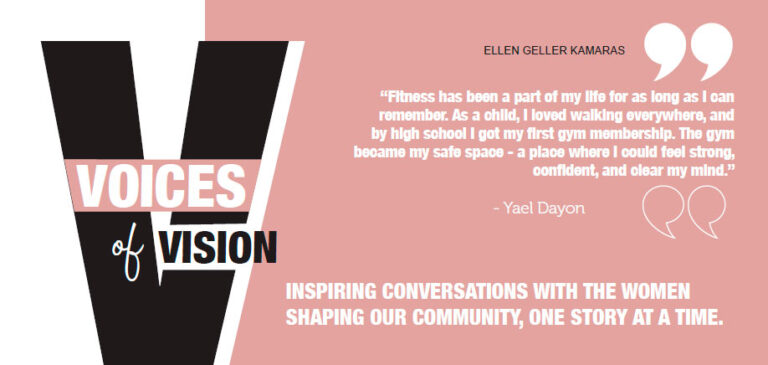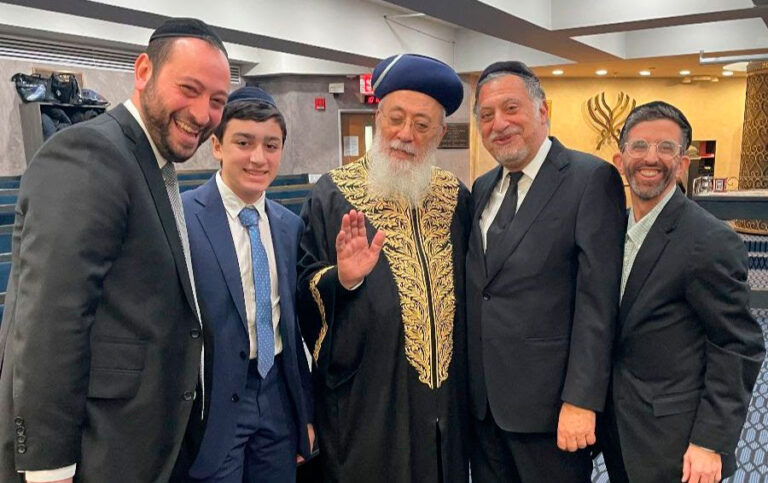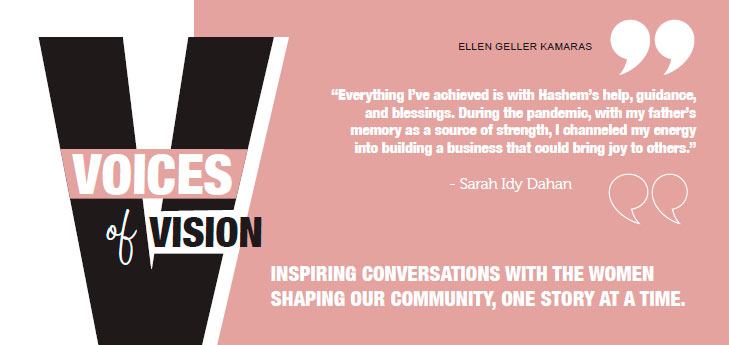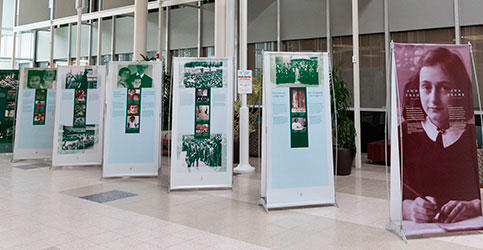Inspiring conversations with the women shaping our community, one story at a time.
Ellen Geller Kamaras
“Everything I’ve achieved is with Hashem’s help, guidance, and blessings. During the pandemic, with my father’s memory as a source of strength, I channeled my energy into building a business that could bring joy to others.” – Sarah Idy Dahan
Please meet the vibrant and talented Sarah Idy Dahan, literally a fine princess. She is a successful hairstylist and founder of Hummingbird, a baby product/fashion brand that focuses on mothers.
Her middle name, Idy, is for Aidel. The Yiddish meaning is delicate or noble, whereas the Hebrew denotes that Hashem is eternal.
Sarah Idy’s last name Dahan is unique in that it is her parents’ last name and her married name. She married a man with the exact first and last name as her beloved father, Rabbi Chaim Dahan, zt”l.
Sarah Idy strives to live up to her meaningful names, and her parents’ and grandparents’ values and teachings.
Early years
Sarah Idy, the oldest of two girls, was born in Cleveland, Ohio, to Rivkah Cabasso Dahan and Chaim Yechezkel Shraga Dahan, a”h. Her mother was a Brooklyn-raised Syrian girl and her father, half Moroccan and half Hungarian, grew up in Monsey, NY. Sarah Idy refers to her family as a real “cholent or hameen!”
Chaim Dahan, a rabbi, hazan, and public speaker, studied at Telz Yeshiva in Cleveland for twenty years. He also served as a Rebbe at Shaare Torah in Brooklyn for two decades. Chaim’s father was brought from Morocco to NY by the Ashkenazi Mir Yeshiva. When Chaim’s Rosh Yeshiva in Telz, Rav Mordechai Gifter, zt”l, found out he was Sephardic, he encouraged Chaim to return to his Sephardic roots and heritage.
Sarah Idy’s mother was most recently the principal of YDE Girls Elementary School and is now living in Long Branch, close to her daughters. She is a School Leadership Consultant and is in private practice as a Therapeutic Energy Practitioner.
The Dahan family moved to Brooklyn when Sarah Idy was a year old. She attended Yeshiva Ateret Torah from first grade through high school. While she was a hard-working student, she admits to having loved school mostly for the social aspect. “As a child and adult, I was, and am still, a social butterfly. I always had many friends and loved meeting new people.”
Career Passions
Sarah Idy developed her passion for hairstyling at a young age while watching her paternal grandmother Ruthie Dahan, a significant role model, in action. Ruthie was a hairdresser and makeup artist and worked avidly until the day she died. “My grandmother had a magical way of making people feel beautiful, always wearing the biggest smile, and she became an integral part of everyone’s celebrations, helping them feel like their best selves.”
Determined to enroll in a professional program, Sarah Idy convinced the manager of a hair styling course to admit her at the tender age of ten. She still remembers introducing herself confidently to a room full of 12th graders and married women.
At ten year of age, Sarah Idy was cutting hair and doing makeup for bar mitzvahs and engagement parties.
After high school, Sarah Idy enrolled in cosmetology school and then a makeup certification program. She did considerable research and her father accompanied her on all her interviews. Her experience at ARROJO Academy – Cosmetology School in trendy SOHO, was exhilarating and enabled her to flourish as a hairstylist.
Her hair business, HairbySarahIdy,allows Sarah Idy to fulfill her passion of making people feel good about themselves and bringing them happiness. “I have the privilege of helping them feel beautiful with the talents Hashem gave me.” Her clients come through word of mouth.
In addition to one-on-one and group hairstyling for semachot, Sarah Idy gives hairstyling classes for teenagers, teaching them to do their own hair. She feels honored to work with brides on their special day and to share their cherished moments with them.
One of her proudest accomplishments was doing hair on photoshoots for prominent clothing brands such as Junee’s and Tottini. It was exciting for her to see her work featured on the company websites and on posters in stores.
Sarah Idy’s Essence
Sarah Idy is warm, vivacious, spiritual, and easy to talk to. She describes herself as happy, creative, determined, passionate, authentic, and energetic. Sarah Idy added that she is detail-oriented, motivated, and a go-getter. “Whatever I put my mind to, I give it my all. I’m proud of my ongoing spiritual growth and my efforts to continuously become a better person, the best example for my family.”
Sarah Idy is grateful for the incredible values and life lessons her parents modeled. “They raised me with immense love and confidence, instilling in me the belief that I could achieve success in whatever I set my mind to and providing the tools to reach my highest goals.”
She feels comfortable both in the Sephardic and Ashkenaz worlds. Sarah Idy grew up in the Ateret Torah community and spent summers in the Ashkenazi Cleveland community.
A Match Is Made
Three young men with the last name “Dahan” were suggested to Sarah Idy as matches. None were related to her father. Her parents consulted a rabbi to confirm it was permissible to meet Chaim Menachem Dahan from Montreal who had the same name as her father’s. The mashgiach from Chaim’s kollel, Rabbi Benzion Kaye, made the shidduch.
When her future husband entered her home for their first date, Chaim recognized her father and said, “I remember we met when you spoke at Rabbi Diamond’s yeshiva three years ago and I remember exactly what you said: ‘the city of happiness is in the state of mind.’” Chaim earned major points with her dad with that recollection.
Sarah Idy and Chaim first lived in Lakewood, NJ, and moved to Long Branch recently. Her sister Zahava and her mother followed. The couple have three young children, a five-year-old son, a three-year-old daughter, and a boy almost two. Sarah Idy’s personal passions are her husband and children.
Hummingbird is Born
Hummingbird was conceived during the pandemic. Sarah Idy wasn’t doing hairstyling since semachot were on hold and there were many social distancing restrictions. However, the most significant impact of the coronavirus was personal. Sarah Idy’s father passed away suddenly from Covid. “Losing him turned my world upside down and left an immense void in my life. He was my best friend and also one of my greatest inspirations.”
“Becoming a first-time mother sparked a desire in me to create something meaningful, which led to the launch of Hummingbird. This new chapter coincided with a difficult time, as I was coping with the loss of my father. Motherhood was the true catalyst for turning my vision into a reality.”
Sarah Idy’s husband also played a pivotal role. It was his dream to start a business, and she credits him with being the driving force behind Hummingbird’s success.
Hummingbird’s mission is to inspire confidence in moms by providing products that blend comfort and elegance while creating a sense of connection and belonging. Every product is made with care, quality and safety, and attention to detail is prioritized.
Why Hummingbird? Hummingbirds go from plant to plant, pollenating, ensuring that natural vegetation and flowers thrive. They do this vital work lovingly and even hum while working. Mommies are very similar in that they bring the next generation to life and nurture the young into thriving adults.
Hummingbird’s functional and stylish products include cozy baby blankets, pacifier clips, buddy blankets, and other thoughtfully designed accessories. The blankets are hand-sewn in the U.S. and the other products are manufactured overseas in factories that align with the Dahans’ values and high ethical and safety standards. “I am truly blessed to be part of mothers’ special moments. Hearing positive feedback is incredibly rewarding and building positive relationships is what makes my business successful. I treasure spotting my blankets and shoes around town.”
Sarah Idy puts herself and her love into her products. She wraps all the gifts herself or with help from her kids and she includes handwritten notes. Sarah Idy listens to feedback, and treats every customer with the same respect and kindness she would expect.
Family and Balance
Being present for her children is Sarah Idy’s top priority. She generally plans her work calendar for HairbySarahIdy and Hummingbird around her children’s schedule. “I make it a point to put down my phone when they’re home from school and need my attention.” Her husband and children are her biggest cheerleaders for her hairstyling business and for Hummingbird.
Community
“I am incredibly blessed to be part of the Syrian community with its rich heritage and strong sense of connection.” Her family has become part of the Long Branch Rabbi Diamond Kollel community, a wonderful source of support and inspiration.
Sarah Idy contributes to the community by being an actively supportive neighbor and friend. “Whether it’s sharing advice, lending a hand, or celebrating milestones, community means showing up for each other and fostering meaningful relationships.”
Sarah Idy enjoys unwinding with a good book and a cup of tea.
What’s Next?
AtHummingbird, Sarah Idy is formulating content and programs to help mommies thrive and feel supported.
Contact Sarah Idy at hello@hummbrand.com, on WhatsApp (718-986-5466), which includes a complete product catalog, or on her website, https://hummbrand.com/.












